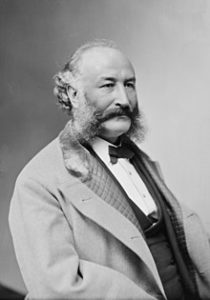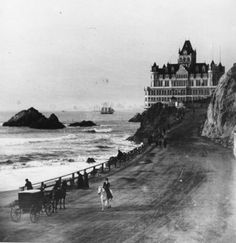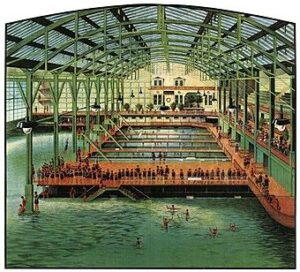
Las Brisas, Chile [image via luxatic.com]
But the “granddaddy” of such acquatic complexes did exist in America, more than a century ago. The “Sutro Baths,” as they were called, were located in San Francisco and provide the setting for a memorable scene in my novel The Art of Love, which is Book One of my historical fiction series “The Golden City.”

Adolph Sutro [image via Wikipedia]
West of the city, one of Sutro’s prized properties overlooked the Pacific Ocean at a place called “Land’s End.” It was windswept and sandy, but offered spectacular views of Seal Rocks and Ocean Beach, and was the site of a fashionable resort called the Cliff House. Unfortunately, Land’s End was a long way from downtown, so only the rich could afford the stagecoach ride from the city center.

Cliff House via Pinterest
Sutro aimed to change all that. In 1881 he made plans to refurbish the Cliff House and turn it into a family-friendly attraction that customers could visit via his own “Sutro Railroad,” which would run between Land’s End and downtown. Despite a devastating fire and other obstacles, he eventually opened the “new” Cliff House in 1896. To many visitors, the renovated restaurant and meeting center looked like a giant gingerbread castle ready to drop into the ocean. Despite (or perhaps because of) its fairytale appearance, it quickly became the “go to” venue for visitors of all income levels who enjoyed dining and dancing by the sea.
But the Cliff House was only part of Sutro’s plan to attract city dwellers. His more ambitious goal was to build the world’s largest public indoor salt-water swimming and entertainment center. In 1888 he offered a large cash prize to the firm who could build what he had in mind, and the same architects who’d designed the revamped Cliff House won the commission.
The natatorium (a fancy word for a building that houses an indoor swimming pool) took several years and incredible ingenuity to build. One problem, for example, was the proximity to the ocean. It required four attempts before the engineers successfully designed and constructed a sea wall strong enough to withstand the force of the waves.
When it finally opened in 1896, the Sutro Baths was a magnificent glass-domed complex featuring seven pools (one of which was spring fed), each heated to a different temperature. Unlike its freshwater counterparts, the saltwater baths used the power of the tides to continuously filter the water. During high tides nearly two million gallons of water would be recycled in about an hour; during low tides, a powerful sea level pump could refill the tanks in about five hours.

The Sutro Baths {image via Wikipedia]
It was a swimmer’s paradise, but had a drawback we might not put up with today: those wanting to take a dip had to rent bathing suits, which were apparently gray (from over-washing) and floppy–decidely not the latest fashion. Still, back then it was no doubt a small price to pay to join in the fun. Bathers could enter the pools in a variety of ways, including trampolines, flying rigs, slides, swings, toboggan slides and diving platforms. Those who weren’t swimming could watch the action from a raised observation deck. That level also had carnival rides and other attractions. Over the years all manner of shows were staged, from beauty pageants, talent shows and swimming championships to trapeze acts, magicians and dwarf boxing matches.
As if all that weren’t enough, Sutro offered a natural history museum, art exhibits, an amphitheater for concerts, an ice-skating rink, and restaurants. Had you lived in San Francisco at the turn of the twentieth century, you might have taken the train and spent many a Sunday afternoon frolicking in the water at the Sutro Baths–along with up to ten thousand of your closest friends!
All good people–and good things–must come to an end. Only two years after opening the popular entertainment center, Adolph Sutro died and his vast holdings fell prey to squabbling heirs.
Even though it miraculously survived the 1906 Earthquake, The Cliff House was gutted by a mysterious fire in 1907 but rebuilt (in a more sedate style, alas) once more. It stayed in business as a popular restaurant and concession of the National Park Service until Covid 19 policies forced its closure at the end of 2020.

Sutro Baths today
[public domain image]
[source: National Park Service, Wikipedia, Historic San Francisco]


